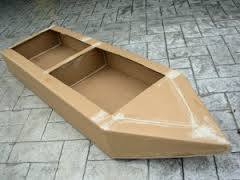
|
Building Boats from Container Board Toledo is home to a fiber mill - a huge mill that turns wood pulp into the wavy bit you see between the exterior layers of cardboard (Specifically: Container board. Cardboard does not have the wavy bit, cardboard is like what cards are made from where container board is much more structurally sound and versatile.) Every year, Toledo hosts a Wooden Boat Show and as part of the fun, we have a Container Board Boat Race. The mill provides a kit of (2) sheets of container board 110"x82" and (1) cardboard tube 164" long, 4.5" dia, with 1/4" thick walls. This is provided for free To obtain your kit and get more info, email Toledo.boatrace@gapac.com.
For this year, our friend Patience emailed me a picture of the type of boat she wanted and I muddled with the design a bit, coming up with what has been jokingly called the Yaquina Shovelnose. The plans I created were for me, so they are a wee bit obtuse. Plus, during the build process, we came up with some improvements. Give me a couple days and I'll have something in the Plans section. When I got to the Boathouse, the Jobcorps kids were there again, wanting to go out. I sent them up the slough and turned to on the container board boats. Patience and Sebastian showed up shortly after I had begun laying out the shovelnose patterns. We cut out one pattern and used it as a template for the other one. I had impressed upon the kids how important it was to keep the template in place while they traced it. They took my instructions to heart. Apparently, holding the template down was exhausting, so they took turns. Joy the Wonderpup came in for an impromptu visit. Once the nose pieces were cut, we laid out the sheet that would become the cockpit. The sides will be straight so we just drew the lines and splined them. Now it was time to apply the contact cement. "OK, guys. Why do you think they cal it Contact Cement?" An excellent learning opportunity. Here's the first hull as we got the nose pieces on. These boats go together amazingly fast. The astute observer would notice our design borrows heavily from our first container board boat project in 2012 where we built the designs presented in the Cardboard Boat Book. The kids could only take so much sustained activity, so it was time to hit the coracles. There was a lot of furious churning of water with *some* movement in a controlled direction. After Connie and the kids left, I turned to on sealing the seams with drywall tape coated with contact cement. I could use duct tape, but where's the fun in that? Cardboard boats tend to fold up in the middle when they fail. I thought to mitigate this by first cutting one of the tubes in half, then ripping it down the middle, then trying to fix them to the bottom. It didn't turn out nearly as well as I had hoped - the "fixing to the bottom" part, I mean. Morning brought a very low tide. Good news, everyone! We got funding to make a new oar house to store our oars, paddles, and PFDs. I had a little time before the help arrived, so I got to cracking. The most complex operation is laying out the nose cones, even though I simplified them as much as possible. Nothing quite so satisfying as when your cutout pops free. We were building two more boats today, no time to refine the design or fiddle about. I made 3 copies of the template in quick order (didn't have to lay on the template, either.) Geoff, Connie, and the kids showed up and we all got busy. Geoff, a naval architect, suggested it would be easier to stiffen the top of the boat than the bottom, and the results would be the same - it wouldn't be able to fold in on itself. Pete, a local high school teacher, came by with Kendra to film our operations. Everybody got interviewed. Good stuff. The thing about contact cement is you need to let it dry for about 20 minutes before assembly. And as we all know, waiting is the hardest part. That's a good day at the boathouse - everybody working. Nose cones folded up, it was time to go to work on the cockpits. These are 28" wide by 82" long, should be able to hold 3 kids or 2 adults with ease. Not yet broken to surrendering their lives to endless toil, the kids were starting to wane. Connie bought us lunch (thank you very much) and I turned them to painting while Geoff and I finished out the other boats. Rather than split the tubes, we decided to just lash them to the top edge of the gunnel. Will it work? Maybe. Um, uh. That's not how I would paint the inside of a boat. Paint Day is also Wear Your Grubbies Day for a very good reason. That was some work, folks. 3 boats in roughly 8 hours of work. Lots of stinky glue, straight edges, and paint. The Toledo Boat Show will be a hoot!
|

